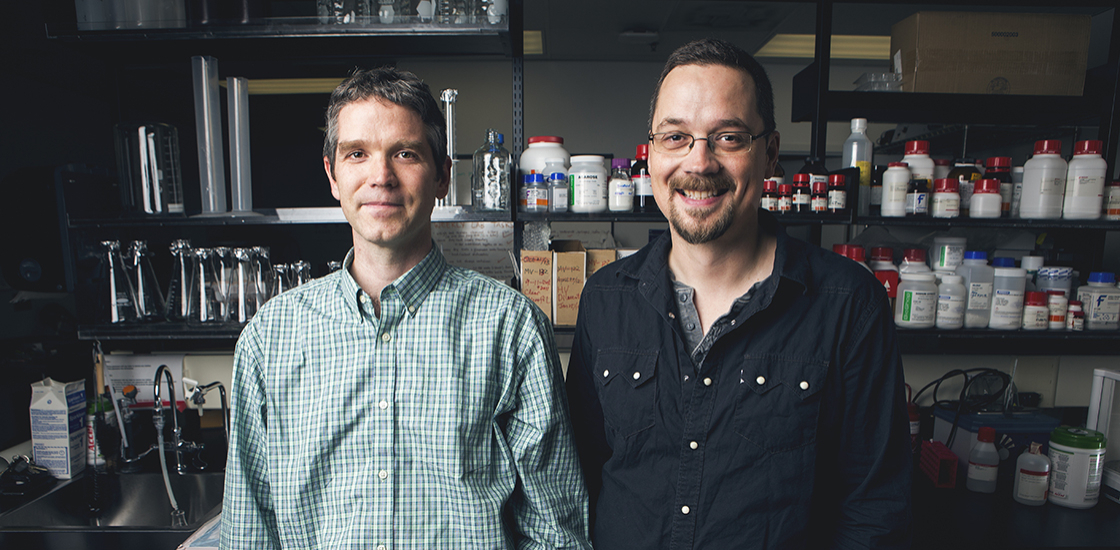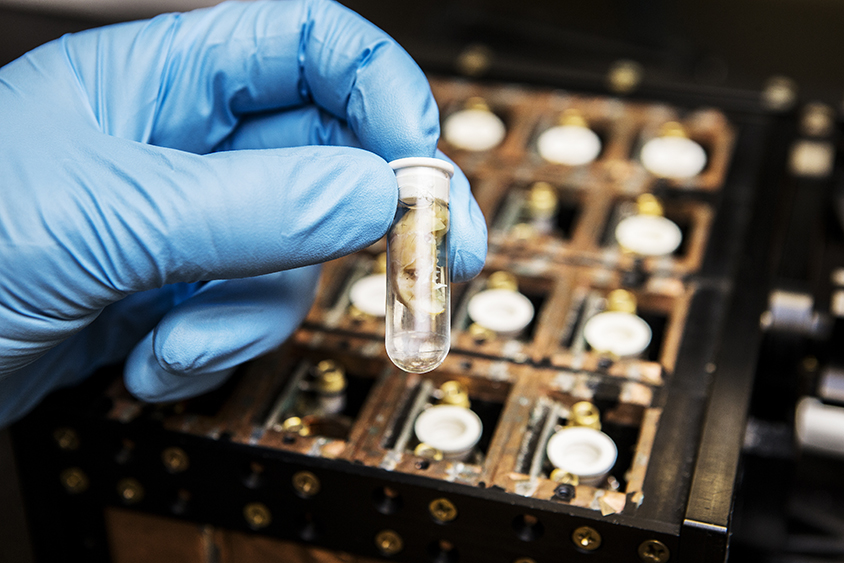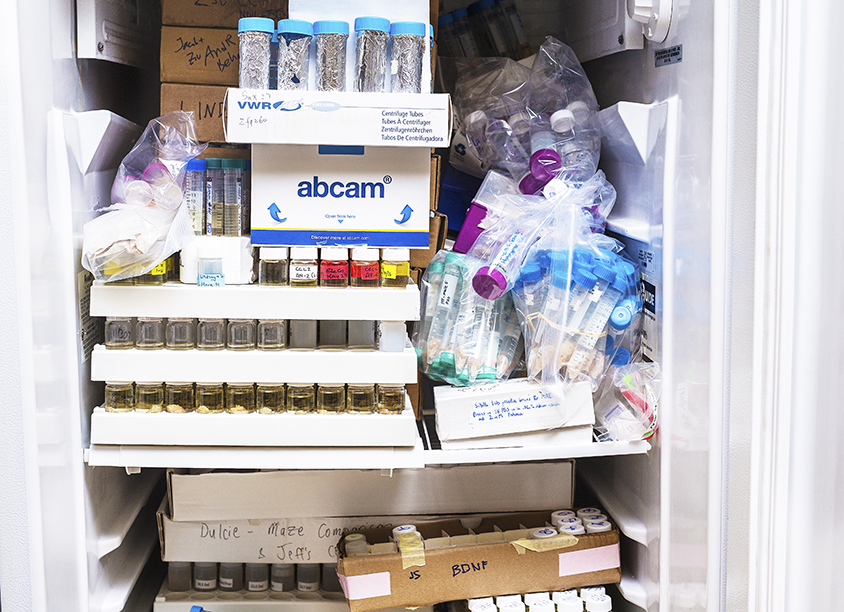Meet the dynamic duo scanning every autism mouse brain
At the Mouse Imaging Centre in Toronto, Jacob Ellegood and Jason Lerch are taking on autism’s complexity by scanning the brain of every autism mouse model they can acquire.

Jacob Ellegood arrived at his first autism meeting buoyed by excitement about his ambitious new project. His goal was to scan the brains of an array of autism mouse models and pinpoint exactly where things go awry. All he had to do was convince some researchers to give him their mice.
He quickly came back down to reality. Nobody had ever heard of Ellegood, then a lowly postdoctoral fellow, or his research partner, Jason Lerch. At the time, seven years ago, the meeting was focused on studying people, not mice. And certainly no one was thinking of scanning mice with magnetic resonance imaging, as Ellegood and Lerch proposed to do.
“It went over like a lead balloon,” Ellegood recalls. “We were outsiders,” he says. More to the point, “people weren’t sure what they could gain from what we were doing.”
With few options for collaborations, Ellegood and Lerch bought an autism mouse strain. A year and a half later, at the Society for Neuroscience annual meeting in San Diego, California, Ellegood showed that these mice, which carry a mutation in NLGN3, an autism candidate gene, have several brain regions that are smaller than those in typical mice. The presentation caught the attention of Jacqueline Crawley, a leading autism mouse behaviorist. Soon after the meeting, Crawley sent Ellegood and Lerch one of her mouse strains. Other teams followed.

The more data the duo collected, the easier it became to convince other groups to collaborate. When Ellegood goes to meetings now, he waits for others to find him. During a mouse genetics session at a conference in May, researchers started to laugh when nearly every presentation credited Ellegood and Lerch as collaborators. At another conference in July, the pair expanded their partnerships to Korea. Altogether, they have so far scanned the brains of 87 mouse models with autism-linked mutations. And their collaborations span 32 teams in 8 countries.
“They’re like the unifiers of the autism field,” says Jill Silverman, assistant professor of psychiatry and behavioral sciences at the University of California, Davis, who is a collaborator. “Even when two different people make [mice with] the same autism mutation and the people are competitors of each other, Jacob has done all the scanning.”
Having a single lab scan so many strains has been a boon for the field, uncovering patterns of brain alterations across different strains.
In 2014, Ellegood and Lerch published their findings from 26 strains. As they quickly discovered, there is no one brain region involved in autism. But the mice fall into three categories: those with unusually large brain regions, unusually small regions or a mix of both. Certain regions are consistently altered in these groups.
The results point to a way to group people with autism. “Their approach really respects the heterogeneity of autism,” says Jeremy Veenstra-VanderWeele, associate professor of psychiatry at Columbia University, who is also a collaborator. “They let the data speak for itself. That’s rare and it’s risky in the current funding environment: Instead of looking for what is obvious, they’re trying to truly discover something new.”
Picking paths:
Ellegood and Lerch didn’t set out to be neuroscientists, much less mouse anatomists. Ellegood studied astrophysics as an undergraduate and Lerch started out in anthropology. Both made the move to neuroscience in graduate school, aiming to better understand human behavior.
Their common interest in brain imaging brought them to the Mouse Imaging Centre at the Hospital for Sick Children in Toronto, Canada — Lerch in 2005 and Ellegood in 2008.
The center’s mission is to illuminate the effects of mutations by scanning genetically engineered mice, using techniques typically reserved for people. It’s an unusual goal, given that researchers typically turn to mice for experiments they can’t do in people. But working with mice allows researchers to isolate a mutation’s effects in a way they cannot in people.
The center’s director, Mark Henkelman, asks every new researcher to pick a condition that can be studied in mice. When Ellegood joined, he proposed to study autism, eager to leverage the imaging center’s ties with the hospital. Lerch started at the center as a postdoctoral associate. When he obtained a faculty position, he took over as principal investigator of the project.
At the time, researchers had linked about 20 genes to the condition — compared with the thousands implicated today. “If I’d known it would get to 1,000 so quickly, I might have chickened out,” Henkelman says. Ellegood and Lerch proved up to the challenge.
Mouse house:
Two to three shipments of mouse brains arrive in Toronto each month with skulls intact, in tubes filled with the preservative formaldehyde. The researchers transfer the brains to a single refrigerator that holds samples from around the world. Scrawls in permanent marker on each tube denote the mouse strain.

Across the laboratory, small rooms house two large scanners specially outfitted for rodent cargo. Yellow lines on the floor warn passersby of the scanners’ powerful magnetic fields, which attract metals and deactivate credit cards.
Down a hallway, an electrical engineer works out of a small office packed with tools, bins of loose hardware and a three-dimensional printer. He retrofitted the scanners, designed for use in people, for tiny rodents. He also fashioned adaptors that allow for the scanning of multiple mouse brains at once.
During the day, the scanners are reserved for researchers scanning live mice. But every night, Ellegood and Lerch line up as many as 16 mouse brains in a machine, running it 14 hours at a stretch to capture cross-sections of the brains at high resolution. They typically scan 10 to 12 mice with the same mutation and an equal number of controls for each experiment. When possible, they include an equal number of female mouse brains, as autism mutations may have gender-specific effects.
The report generated from each experiment details the volumes of 159 brain regions. Silverman usually calls Ellegood for help deciphering the 52-page report that lands in her inbox. “The analysis is crazy; it’s so in depth,” she says.
Bridging the politics:
Ellegood and Lerch’s success in striking up these partnerships stems, in no small part, from their personalities. Without exception, others describe them as a pleasure to work with, as “intensely collaborative,” “thoughtful,” “dependable,” “self-effacing” and quintessentially “Canadian.”
“You always want collaborators who can anticipate questions that you might want to know and don’t make you feel like your lack of knowledge is something you should be embarrassed about,” says Alexander Nord, assistant professor of neuroscience at the University of California, Davis.
Nord asked Ellegood and Lerch to scan the brains of mice missing a copy of CHD8, the top autism candidate gene. Just a few weeks earlier, the pair had agreed to scan another team’s CHD8 mice. They have no problem working with teams that are competitors. In fact, each team appreciates the value in comparing the two strains.
“They were able to bridge the politics,” Nord says. “I was able to enter our mouse model into the bigger conversation by working with them.”
Ellegood and Lerch also haven’t forgotten the even bigger goal: understanding the human brain.
“One thing about the mouse experiments is that you’re controlling every part of what you want to look for: You’re controlling genetics, the environment, it’s very clean,” Lerch says. “But, of course, it’s still a furry little rodent with a tail.”
To bridge the gap between mice and men, he and Ellegood are comparing their results with findings in people with autism. Lerch spends about half his time at the hospital, scanning children with neurodevelopmental conditions. If the brains of children with autism fall into the same three groups as mouse brains do, clinicians might be able to use brain images to predict how a child would respond to treatment. Lerch and Ellegood are also designing clinical trials to test the same drugs simultaneously in children and mice.
Today, Ellegood laughs at his “naïve” first grant title: “Where is autism in the brain?” But his and Lerch’s naïveté paid off: It drove them to look at mouse after mouse to find clear anatomical signals amid all the noise.
Recommended reading
Explore more from The Transmitter

Neuro’s ark: How goats can model neurodegeneration



